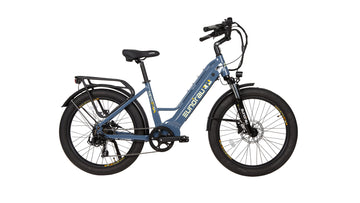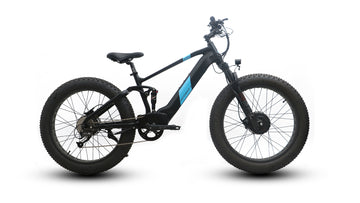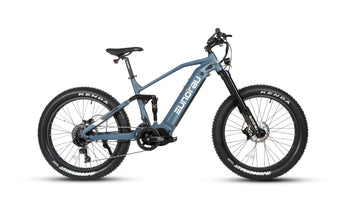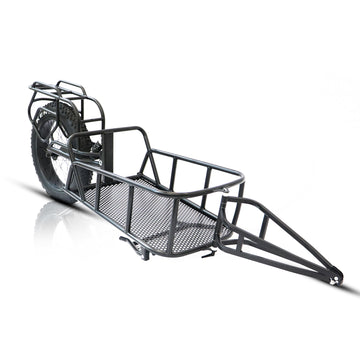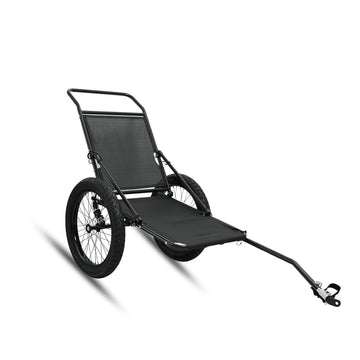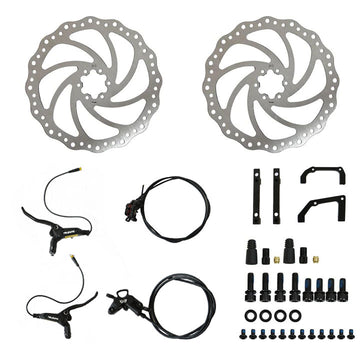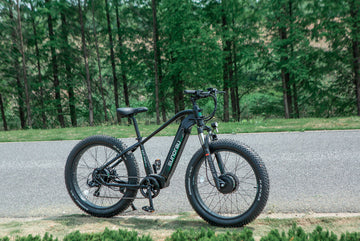
Electric bikes have become the modern rider’s favorite companion, whether for commuting, recreation, or adventure. At the heart of every ebike is its battery—the power source that brings the bike to life. While ebike batteries are designed to be safe, efficient, and long-lasting, one common concern that riders encounter is battery overheating.
At Eunorau, we believe that knowledge is the best form of protection. Understanding why ebike batteries overheat, what factors contribute to it, and how to prevent it can help you ride safely, extend the lifespan of your battery, and get the best performance out of your ebike.
1. Understanding How an Ebike Battery Works
Before we get into overheating, it’s important to understand what’s happening inside your ebike battery.
Most ebikes, including those from Eunorau, use Lithium-ion (Li-ion) batteries. Why? Because they are lightweight, energy-dense, and rechargeable. Each battery is made of individual cells arranged in series and parallel to reach the desired voltage and capacity. For example, a 48V 15Ah battery contains multiple smaller cells working together to deliver power.
Inside the battery:
-
Cathode & Anode: These store and release ions.
-
Electrolyte: The medium through which lithium ions move.
-
Separator: Keeps the anode and cathode apart to prevent short circuits.
-
Battery Management System (BMS): The brain that monitors temperature, charging, discharging, and prevents unsafe conditions.
When everything works smoothly, you get a safe, consistent flow of energy to power your ride. But if something disrupts this balance—excessive heat can build up.

2. Why Heat Matters in a Battery
Batteries naturally generate heat during charging and discharging due to internal resistance. This is normal. However, excessive heat is dangerous because:
-
It accelerates chemical reactions inside the battery, leading to faster degradation.
-
It can cause the battery to lose capacity prematurely.
-
In extreme cases, it may trigger thermal runaway—a chain reaction where the battery keeps heating until it vents, swells, or in rare cases, catches fire.
That’s why overheating isn’t just about comfort—it’s about safety, performance, and longevity.
3. Common Causes of Ebike Battery Overheating
Let’s break down the main reasons why your ebike battery might be overheating.
a) Environmental Temperature
Lithium-ion batteries perform best between 20°C to 25°C (68°F–77°F). Extreme heat outside can raise the battery’s internal temperature quickly. For example:
-
Parking your bike under direct sunlight on a summer day.
-
Riding in desert-like conditions for long hours.
When the ambient temperature is already high, the battery has less “room” to dissipate the additional heat created by normal use.
b) Overcharging the Battery
Charging a battery beyond its recommended voltage can lead to overheating. That’s why modern chargers and BMS systems stop the process automatically once full. However, if:
-
You use a non-original or faulty charger, or
-
The BMS malfunctions,
your battery may overcharge and overheat.
c) Rapid Discharge / Heavy Load
If you’re riding uphill, carrying a passenger, or constantly using high power modes (e.g., turbo or throttle full-speed), the battery discharges rapidly. This high current draw increases internal resistance and produces more heat.
d) Poor Ventilation During Charging
Charging your battery in a closed, poorly ventilated space—such as inside a car trunk or under blankets—prevents heat from escaping, causing it to build up.
e) Internal Cell Imbalance
Within the battery pack, if some cells are weaker than others, they heat up faster. The BMS usually balances cells, but over time or due to poor manufacturing, imbalances can increase heat risk.
f) Old or Damaged Battery
Like people, batteries age. After hundreds of charge cycles, the internal resistance increases, making heat generation more noticeable. If a battery has been dropped, punctured, or exposed to water, its internal structure might be compromised, making it more likely to overheat.
g) Improper Storage
Leaving your ebike battery in:
-
A hot garage during summer, or
-
A freezing car overnight in winter
affects the battery’s chemistry. Heat especially can accelerate degradation and make overheating more likely in normal use.

4. Real-World Scenarios of Battery Overheating
To put theory into practice, here are examples:
-
The Summer Commuter: A rider leaves their ebike parked under direct sunlight at noon. When they return, the battery feels hot to the touch, and when plugged in to charge, it heats up even more.
-
The Mountain Climber: A rider takes their fat-tire ebike on steep mountain trails, always using maximum assist. The battery drains quickly, and the casing becomes warm because of the sustained high current.
-
The Wrong Charger: A rider loses their original charger and buys a cheap replacement online. It delivers the wrong voltage, stressing the cells and creating excess heat.
At Eunorau, we see these patterns often in after-sales support, and that’s why education is so important.
5. How to Tell If Your Battery is Overheating
Signs include:
-
The battery feels hot to the touch (warmer than normal after a ride).
-
You notice reduced performance—shorter range or sudden voltage drops.
-
Charging takes unusually long, or the charger itself becomes very hot.
-
Swelling or deformation of the battery casing.
-
Unusual smells or smoke (in extreme cases).
If you encounter the last two symptoms—stop using the battery immediately and contact a professional.
6. How to Prevent Your Ebike Battery from Overheating
Here are best practices every rider should follow:
a) Charge Smartly
-
Always use the charger that came with your ebike or an official replacement from Eunorau.
-
Charge in a cool, ventilated space.
-
Avoid leaving the battery on the charger overnight for extended periods.
b) Ride Responsibly
-
If you’re climbing steep hills or carrying heavy loads, use pedal assist to share the load with the motor.
-
On extremely hot days, avoid long rides at maximum power mode.
c) Store Properly
-
Keep your battery between 10°C to 25°C (50°F–77°F) when not in use.
-
Never leave it in a hot car or under direct sunlight.
-
For long-term storage, keep the battery at about 50% charge.

d) Regular Maintenance
-
Inspect your battery casing for cracks or swelling.
-
Clean terminals occasionally to avoid corrosion.
-
Ensure firmware updates are applied if your bike’s system supports them.
e) Replace at the Right Time
A typical Lithium-ion battery lasts 3–5 years depending on usage. If your battery shows consistent overheating despite precautions, it’s safer to replace it.
7. What Eunorau Does for Battery Safety
At Eunorau, rider safety is at the heart of our designs. Here’s how we ensure your battery is protected:
-
High-Quality Cells: We use premium cells from trusted manufacturers (Samsung, LG, etc.), which are more stable and reliable.
-
Smart Battery Management System (BMS): Every Eunorau battery includes advanced protection against overcharging, short circuits, overcurrent, and overheating.
-
Rigorous Testing: Our batteries undergo vibration, thermal, and cycle testing to meet international safety standards.
-
Protective Housing: The casing is designed to withstand shocks, moisture, and temperature fluctuations.
-
After-Sales Support: If you encounter any issues, our support team can help diagnose and resolve them quickly.
We also constantly educate our community on safe charging, handling, and riding practices, because knowledge reduces risks.
8. Frequently Asked Questions (FAQ)
Q1: Is it normal for my ebike battery to get warm while charging?
Yes, slight warmth is normal. But if it becomes uncomfortably hot to touch, stop charging and check for issues.
Q2: Can I ride my ebike in very hot weather?
Yes, but take breaks, avoid extreme load on the motor, and store your bike in shade when possible.
Q3: What should I do if my battery overheats during a ride?
Stop riding, turn off the power, and let it cool naturally. Do not pour water on it.
Q4: Can I use any charger as long as the voltage matches?
No. Even if the voltage seems correct, the current and safety circuits may differ. Always use the official charger.
Q5: How long does an ebike battery last before overheating becomes a risk?
Most batteries last 500–1000 full charge cycles. As they age, internal resistance rises, making heat more likely. Monitor performance and replace when necessary.
Your ebike battery is like the heart of your ride—it deserves care, attention, and respect. While overheating can happen, it is largely preventable with the right knowledge and habits.
At Eunorau, we build our bikes with advanced safety systems, premium batteries, and clear guidance so that you can ride with confidence. By combining technology with smart rider behavior, you can enjoy years of safe, efficient, and powerful ebike adventures.
So next time you hit the road or trail, remember: take care of your battery, and it will take care of you.


